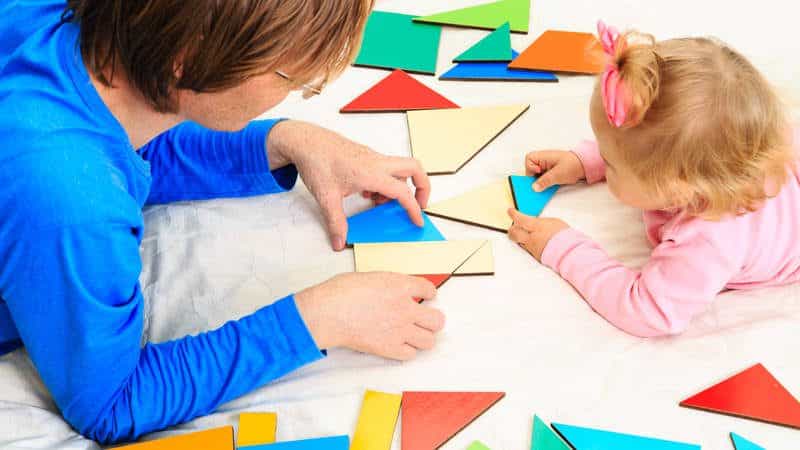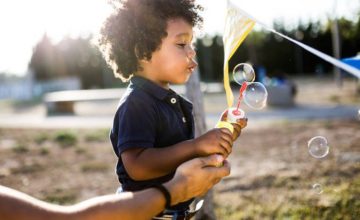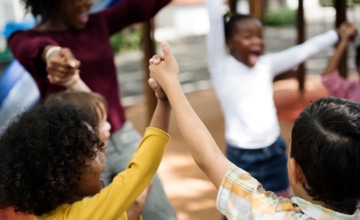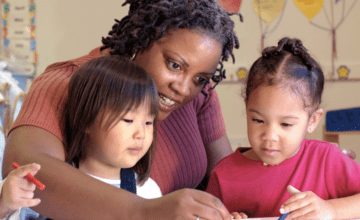Learn how infants and toddlers develop play skills from birth to 3, playing with toddlers, and what toys and activities are appropriate for their age.
What babies started to do and learn in their first 12 months really takes off during the next 12. Through their play experiences and interactions with you (remember, you are still their favorite toy!), they continue to figure out how the world around them works. Read on to learn more about playing with toddlers during this time—and what you can do to support your toddler’s development.
What Does It Do?
Toddlers are learning how objects are used together. This is why they enjoy filling-and-dumping water, sand, and blocks. Toddlers are also making connections between objects—the reason they like placing little people on a toy bus. Toddlers are learning about sizes as they stack rings. They’re noticing similarities when they line up two toy cars that look the same.
TOYS TO EXPLORE:
- Pop-beads or chunky interlocking plastic blocks
- Plastic spoon and cup
- Blocks and bucket
- Nesting cups/rings or shape-sorters
- Busy box with button to push, switch, and dial to turn
- Chunky wooden puzzles
HELPING YOUR TODDLER PLAY AND LEARN:
- Offer toys like these to your toddler and just watch to see what she does. Let her try to figure out how they work and discover what she can do with them.
- Then show your toddler how to use these toys in new ways. For example, you might put the spoon in the cup and stir. Then hand it to him and see what he does. Or pretend to give his stuffed bear a sip.
First Friends and Early Social Skills
Beginning at about 12 months, most young toddlers enjoy playing near peers. They may play games like “Ring Around the Rosie” or “chase” with another child, or join a peer in filling a bucket with mulch on the playground. These moments may not last long, but they give toddlers a sense of what it means to be a friend and have a friend.
TOYS TO EXPLORE:
- Musical instruments
- Sand/water play
- Art activities, such as painting or chalk
- Toy cars or trains, with one available for each child
HELPING YOUR TODDLER PLAY AND LEARN:
- Create a toddler band by giving each child an instrument or scarf to shake along to the music. Or give each toddler a paint brush and unroll a long roll of paper so everyone has a place to paint. This helps little ones experience the joy of peers without the pressure of sharing!
- Model the words children should use when playing with others, including “Hi! I’m Logan,” “Can I play?”, “My turn?”, and “Thank you.” Toddlers will need to hear these words many, many times before they learn to use them. (This is one area where repetition is really important!)
Can You Hear Me Now? Building Communication Skills
Your 1-year-old is communicating with you using a combination of sounds, gestures, and facial expressions. She’ll likely begin using spoken language with one word, but her vocabulary will grow steadily as you continue to label, comment, and ask questions. She may not say much at first, but she understands almost everything you say!
TOYS TO EXPLORE:
- Toy telephone
- Child-safe mirror
- Dolls, stuffed animals, and puppets
HELPING YOUR TODDLER PLAY AND LEARN:
- Use a toy telephone to help your child “talk” to you or other family members. Use dolls or puppets to “talk” with your child. Sit with your child in front of a mirror and say, “hello!” to each other.
- Ask your child to do a “one-step” request—this means asking him to do one thing, such as “please get your shoes” or “pick up the ball, please.” As your child approaches age 2, try adding a second step: “Please pick up the ball and give it to me.”
Playing with Toddlers: They’re Moving Now
Toddlers are learning to walk, run, climb, use stairs, and throw a ball. This means they need lots of active playtime to build strength, balance, and coordination. Because toddlers don’t understand rules yet, they benefit from free play when they can explore their own way.
TOYS TO EXPLORE:
- Balls of different sizes to roll, throw, and chase
- Push toys
- Toys that can be pulled while walking (a toy dog on a string; a wagon)
- Tunnel (purchased or homemade from a moving box)
- Child-size stool to climb onto and jump off of (with supervision)
HELPING YOUR TODDLER PLAY AND LEARN:
- Create a toddler obstacle course where your child has a chance to crawl (through a moving box), climb (over a cushion), bounce (on a pile of blankets), and roll toward you for a kiss.
- Throw a soft playground ball and see if your child will run or crawl to get it. Or just roll the ball back-and-forth to one another—a game that builds social skills like turn-taking.





